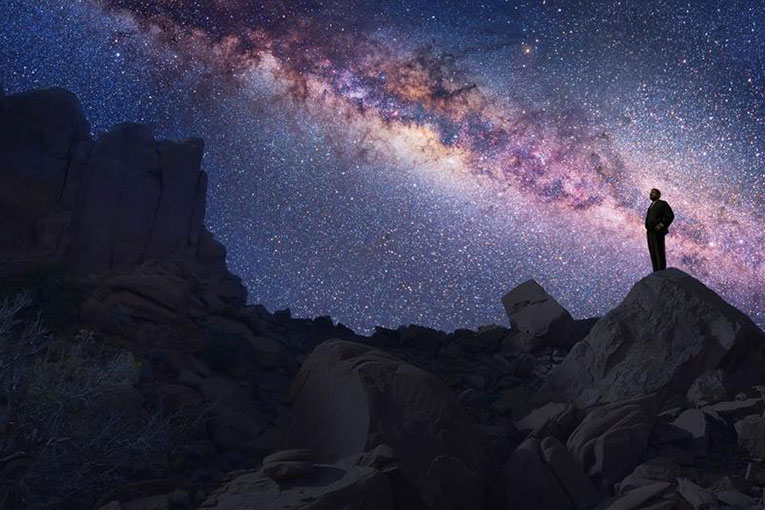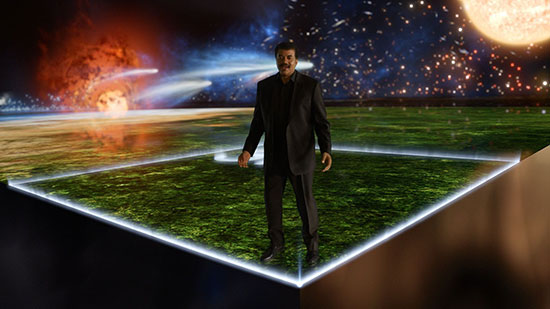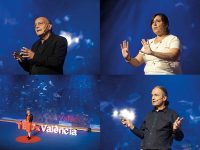
 National Geographic Channel National Geographic Channel |
||
|
In 1980 an astronomer proved science communication could be compelling and entertaining for millions of people. It started with Carl Sagan’s «The Cosmos is all that is or was or ever will be», with which he entered the televisions of North Americans to speak about the great misteries of the universe. Evocative titles such as «Harmony of the Worlds», «Heaven and Hell», «Blues for a Red Planet» or «Who Speaks for Earth?» named the episodes of Cosmos: A Personal Voyage. The program arrived to Spanish homes during prime time on 15 July 1982, and was broadcasted by TVE (the Spanish public television channel), hooking the audience for all thirteen episodes. They followed Sagan in his voyage across time and space. Sagan’s charisma and his ability to speak about science in a comprehensible language for television, together with new and original special effects used to show the complexity of the universe to the last detail and the music by Greek composer Vangelis, were the weapons they used to captivate the audience in a documentary series unequaled until now. Thirty-four years after the first Cosmos, the science series comes back renewed, and simulteneously broadcasted in 180 countries in 48 different languages. Under the subtitle A Spacetime Odyssey, the new series was premiered on 10 March in all Fox International Channels (FIC). Behind it there is the tenacity of two of the creators of the original series (the third one was the scientist and astronomer): Ann Druyan, the wife of the communicator, and Steven Soter, astronomer, scriptwriter and producer. Druyan has been trying to convince of the necessity for a new 21st century Cosmos for years, and National Geographic Channel made it possible. Neil deGrasse Tyson, astrophysicist and Sagan’s disciple, pilots the spaceship in these thirteen new episodes, presented as «a transcendent experience – a vision of the cosmos on the grandest scale we know». The director of the Hayden Planetarium in New York takes the baton from the one who introduced him to astrophysics, and tries to gather again an audience that is fascinated with science. |
«The original programme managed for thirteen episodes that the audience followed Sagan in his voyage across time and space»
«Neil deGrasse Tyson takes the baton from the one who introduced him to astrophysics, and tries to gather again an audience that is fascinated with science» |
|
 National Geographic Channel National Geographic Channel |
«It is visually stunning, it has moments of great impact, and the nods to the original Cosmos give it emotion» Ángel Gómez Roldán |
|
|
In the first episode, «Standing Up in the Milky Way», deGrasse reviews the location of the Earth in the cosmos and explains its place in the universe and the cosmic calendar. In addition, he recovers the figure of Giordano Bruno, turned into a martyr for science due to his defence of the heliocentric model. References to Carl Sagan, the pioneer, will also be present in the show. The first episode left no scientists and popularisers unaffected. That is the case of Ángel Gómez Roldán, science communicator and director of the magazine Astronomía, who admits that «being honest, this heir to Cosmos disappointed me a bit. It is visually stunning, it has moments of great impact, and the nods to the original Cosmos give an emotion that reminded me of my feelings when I watched the show as a teenager. Personally, and even if it sounds like a cliché, Cosmos left a deep mark on me and was decissive for my understanding of the world and my professional career. Therefore, my expectations are probably too high and are conditioned by my personal experience.» Francisco Román Villatoro, PhD in Mathematics, professor at the University of Málaga and science populariser in the blog La Ciencia de la Mula Francis, explains that, generally speaking, he liked the first episode of the new Cosmos, although he feels sorry as a science populariser and adds «Neil deGrasse Tyson, as an astronomer, should be ashamed of the number of scientific inaccuracies in the first episode. The excuse that the target audience won’t know any better is not valid. I was expecting rigorous science, not science as drawn by artists who do not understand the difference between Saturn’s rings and the asteroid belt, or who never saw a photo of the Sun, or Pluto and its satellites, or reliable astist renderings of the Milky Way, to cite some examples.» He also claims that «the best possible legacy would have been for Tyson to take over control and work on the new Cosmos, body and soul. I hope I am wrong, but a decade from now, people will still be talking about Sagan’s Cosmos and no one will remember Tyson doing a clumsy imitation. The Neil we all admire is nowhere in the new Cosmos. The script kills the populariser, and I would have liked to see the true Neil deGrasse Tyson.» Daniel Marín is another one of those children who decided to follow a scientific career encouraged by Sagan’s words. He is an astrophysicist and science populariser, awarded several times for his blog Eureka, in which he says he is speechless after watching «Standing Up in the Milky Way». «Simply amazing. The new Cosmos is not perfect, by all means, but it retains the spirit of the original show. It is visually stunning, even overwhelming, but it does not abuse effects as current documentaries often do», he continues in the entry. And he adds: «If this new show helps passing the torch of knowledge to today’s youth, it is very welcome. A new generation deserves to enjoy Cosmos as we did years ago.» These are the reactions to the first episode of Cosmos: A Spacetime Odyssey. A journey that has just begun. Because as Ángel Gómez says, although he was not shocked by this first episode, «the show is promising. Next episodes will say.» Íngrid Lafita. Journalist (Valencia) |
«The best possible legacy would have been for Tyson to take over control and work on the new Cosmos, body and soul» Francisco Román Villatoro
«If this new show helps passing the torch of knowledge to today’s youth, it is very welcome. A new generation deserves to enjoy Cosmos as we did» Daniel Marín |
|





